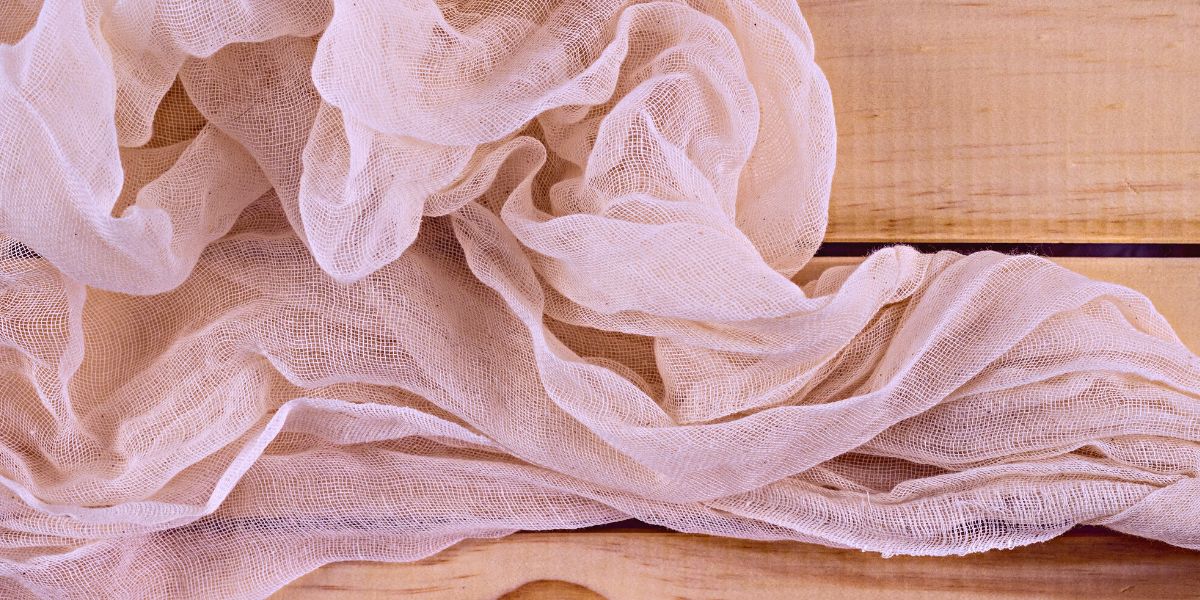Yes, cheesecloth can be washed. In fact, it is important to wash cheesecloth before using it for the first time, as it may contain impurities and debris from the manufacturing process.
By washing your cheesecloth, you can remove any dirt, debris, and sizing that may be present, which can help prevent contamination of your food or other materials that you use the cheesecloth for.
Dos and don’ts of washing cheesecloth
Dos
- Wash the cheesecloth before using it for the first time to remove any impurities and debris.
- Use warm water and a mild detergent when washing the cheesecloth.
- Gently agitate the cheesecloth in the water to remove any dirt or debris.
- Rinse the cheesecloth thoroughly with clean water to remove all the soap.
- Squeeze out any excess water gently without wringing too hard to avoid tearing the fabric.
- Hang the cheesecloth to air dry or place it in the dryer on low heat.
- Store the washed and dried cheesecloth in a clean and dry place until ready to use.
Don’ts
- Use bleach or harsh chemicals to wash cheesecloth, as this can damage the fabric and affect its performance.
- Soak the cheesecloth in hot water or expose it to high heat, as this can shrink or distort the fabric.
- Wring the cheesecloth too hard or twist it, as this can cause the fabric to tear.
- Use fabric softener when washing cheesecloth, as it can leave a residue that affects the fabric’s performance.
5-step guide to washing cheesecloth
Step 1
Prepare the washing solution
Fill a sink or a large bowl with warm water and add a small amount of mild detergent. Stir the water with your hand to ensure the detergent is evenly mixed.
Step 2
Soak the cheesecloth
Place the cheesecloth in the washing solution and gently agitate it with your hands to loosen any dirt or debris. Let it soak for 15-20 minutes.
Step 3
Rinse the cheesecloth
Take the cheesecloth out of the washing solution and rinse it thoroughly with clean water to remove any soap residue. Gently squeeze the cheesecloth to remove excess water.
Step 4
Dry the cheesecloth
Hang the cheesecloth to air dry, or place it in the dryer on low heat. Avoid exposing the cheesecloth to high heat, as this can shrink or distort the fabric.
Step 5
Store the cheesecloth
Once the cheesecloth is dry, fold it neatly and store it in a clean, dry place until ready to use.
FAQs
Can I machine wash cheesecloth?
Yes, you can machine wash cheesecloth, but it is recommended to use a gentle cycle and avoid using high heat when drying.
Do I need to wash cheesecloth before using it?
Yes, it is recommended to wash cheesecloth before using it for the first time to remove any impurities and debris.
What detergent should I use to wash cheesecloth?
Use a mild detergent, such as dish soap or laundry detergent, to wash cheesecloth.
How often should I wash my cheesecloth?
It depends on how frequently you use it and what you use it for. Generally, it is recommended to wash cheesecloth after each use or when it becomes visibly dirty.
Can I iron cheesecloth after washing it?
Yes, you can iron cheesecloth on low heat after washing it, but be careful not to apply too much heat, as this can damage the fabric.
Final thoughts 💭
Cheesecloth is a lightweight, gauzy fabric that is commonly used in cooking, baking, and household tasks such as cleaning and polishing. To ensure that the cheesecloth is clean and hygienic, it is recommended to wash it before using it for the first time and after each use.
To wash cheesecloth, it is best to use a mild detergent and warm water, gently agitate the cloth to remove any dirt and debris, rinse it thoroughly, and hang it to air dry or place it in the dryer on low heat. Avoid using bleach, fabric softener, and exposing the cheesecloth to high heat, which can damage the fabric.
It is also important to store the washed and dried cheesecloth in a clean, dry place until ready to use. By following these tips, you can ensure that your cheesecloth stays clean and in good condition for multiple uses.





Leave a Reply